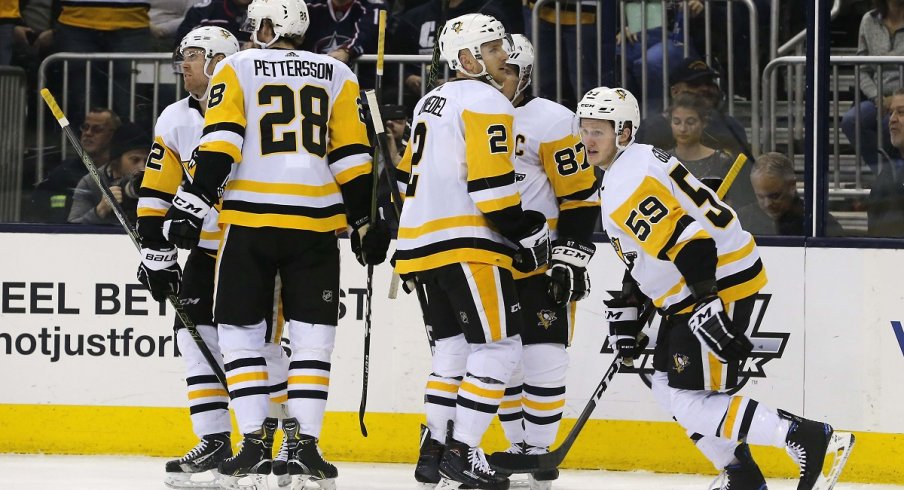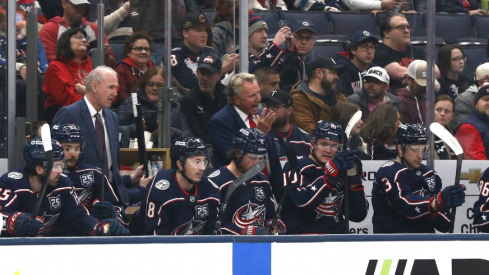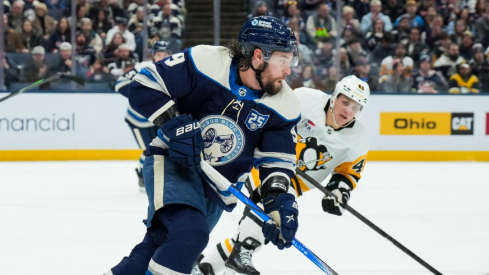There aren't a ton of positives to draw on coming out of the Blue Jackets most recent loss, a 5-2 thumping at the hands of the Pittsburgh Penguins.
They took a period to wake up. Their goalie that has historically struggled to shut down the Penguins continued to struggle against the Penguins, giving up four goals. Their new toys (Adam McQuaid and Ryan Dzingel) played in a limited role. But if there was one problem that really fueled the Penguins victory, it would be bad decisions and turnovers delivered by Blue Jackets defensemen.
It was a constant struggle, and nearly every goal the Penguins scored was directly attributable to a turnover or a glaring miscue from a Blue Jackets defenseman. The first goal, a beautiful three-way passing play between Patric Hornqvist, Sidney Crosby, and Jake Guentzel, did not come off a turnover, so we'll ignore that for purposes of this exercise.
Playing defense is extremely difficult, especially at the NHL level. I'm not here to argue that. These are players that make a living making split-second decisions that are typically much more consequential than forwards.
But after laying a dud in a huge game and entering the final 20 games of the season on the wrong side of the playoff line, I'm feeling rather ornery. So here's a synopsis of goals 2-5, who/what caused them, and what that player can do differently next time.
Goal #2
JARED MCCANN WRISTS ONE HOME TO EXTEND THE PENGUINS LEAD!#LetsGoPens pic.twitter.com/xkQ6a4UFOh
— Hockey Daily (@HockeyDaily365) February 27, 2019
The play starts with David Savard behind his own net. He has an outlet in Artemi Panarin on his strong (right) side, but chooses not to pass to him because Bryan Rust (#17 on Pittsburgh) is in good position. He has an outlet in Zach Werenski on his left side, but doesn't pass it because, well, I don't know. Maybe he thought the Penguins would jump the pass. In any case, he tries a neutral zone bank pass to Pierre-Luc Dubois, who is skating backwards. It doesn't connect.
Once Pittsburgh gains possession, Matt Cullen (#7) feeds Jared McCann (#19), who scores. Ironically, Savard compounds his own mistake, screening Sergei Bobrovsky, who never reacted to the shot.
Goal #3
EVGENI MALKIN BLISTERS ONE HOME FOR THE PENGUINS!#LetsGoPens pic.twitter.com/r2OXICZnSn
— Hockey Daily (@HockeyDaily365) February 27, 2019
The video starts with Seth Jones retrieving the puck and making a bank pass to his partner, Scott Harrington. Harrington decides to let the puck bounce in front of him instead of playing it in his skates. He has just an instant to find the puck off the boards, but isn't able to catch it cleanly. He recovers, but has his head down as it took him longer than it should have to find the puck, and he is immediately hounded by Phil Kessel.
Because his head is down, he has no idea where the pressure (Kessel) is coming from. Kessel forces the puck into the middle, where Zach Aston-Reese plays it in the vicinity of Evgeni Malkin. Malkin turns and fires a hard but seemingly innocuous shot at the net, but it kicks off Jones and into the net.
Next time, Harrington should make the simple play off the wall, as he should know that the Penguins would bring pressure to filter him into the middle of the ice, and as evidenced in this video, Kessel and Aston-Reese were both there to force the turnover.
Goal #4
JARED MCCANN AGAIN! PENGUINS LEAD BY 2 LATE!#LetsGoPens pic.twitter.com/g4wgTpdc4z
— Hockey Daily (@HockeyDaily365) February 27, 2019
This was the "back-breaker" goal, McCann's second of the game that gave the Penguins a 4-2 lead with under seven minutes to play. It's especially frustrating given the Blue Jackets starting this play in the Penguins zone with some sustained pressure, but it dissipates quickly.
It's a pretty simple play. The Penguins defense rims the puck around the wall, and the winger tips it up towards a streaking McCann. Harrington wisely chooses to respect McCann's speed, but gets caught flat-footed. He gets a stick on the puck, but as McCann and Harrington jostle for puck control, McCann has the speed to poke it past him. If you stop the video at 0:08, you'll see that clearly, as Harrington's feet appear stuck in the mud.
David Savard now has to play a 2-on-1, as Boone Jenner chooses now would be a good time to stop backchecking (teaching moment: Jenner does the hard part perfectly, getting back to aid his defensemen, and is in perfect position to help Harrington. Why he chose to not finish his backcheck is either a) he thought Harrington was in good shape defensively or b) he was lazy/at the end of his shift. Either way, shame on him).
McCann then beats Bobrovsky to the stick side in a goal that Bobrovsky would want back. Next time, Harrington should keep retreating and played the body of McCann instead of hoping his baseball skills were superior to his opponent.
The irony in a goalie getting blamed for not coming up with a save after his defenseman gets walked and his center doesn't track back hard enough isn't lost on everyone.
Goal #5
The game was out of reach by the time Crosby tallied the empty netter to make it 5-2, but a defensive miscue is a defensive miscue. I have to show it. Rules are rules.
Seth Jones goes to retrieve a puck with eight seconds to go, his back facing Crosby and the rest of the ice. Love or hate Crosby, but the game's elite know all the subtle tricks. What appears as Jones simply over-skating the puck is actually a wizardly stick check from Crosby. It's likely that Jones either didn't expect pressure, or, more likely, didn't expect that he was in a vulnerable position.
If you freeze the video at 0:33, you'll see that Jones' body is no longer between the puck and Crosby. He's reaching for the puck instead of using his body to shield it. As soon as he does that, Crosby sees a weakness and exploits his pressure point, giving a quick jab right near the top of Jones' stick. It's the kind of goal that doesn't matter but is a learning moment for Jones. And it's the kind of play from Crosby that separate him from the 99%.


